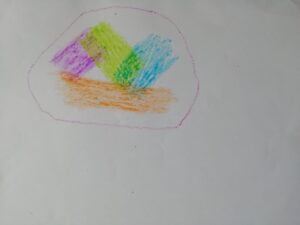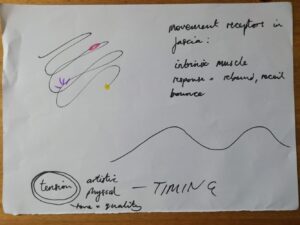Group rehearsal – week 4
- by Marie
- in research fascia
- posted June 17, 2021
16/06/2021 Zoë, Jan-Ming, Josephine
Studio rehearsal in the morning
1) Score 1: move with proprioceptive awareness in solo
We carry on with dancing in solo but focusing on our proprioception, or our awareness of the body in space. Proprioceptors are located in the deep and superficial fascia, within the muscles, tendons, ligaments, joints and some such as the interstitial receptors are found almost everywhere in the body (Lesondak, 2017, p.76-80). Amongst them are the Golgi tendon organ, the muscle spindles, the Ruffini and Pacini corpuscles as well as the interstitial receptors. These last three are mechanoreceptors. Andrea Olsen lists all of the touch receptors and proprioceptors in her Book Body and earth: an experiential guide (2002, p.65)
I am also aware of these receptors because of my studies as a sports massage therapist, and because I use two different remedial soft tissue techniques involving these receptors: muscle energy technique (involving Golgi tendon organ and muscle spindles) and soft tissue release (working with fascia and mechanoreceptors).
Kevin O’Connor and Joseph Dumit used in their practice as research investigation different types of touch that would involve specific mechanoreceptors, either applying light touch, compression or vibration (2016). Their findings show that the experience of applying different types of touch sensitized the movers to various types of readiness, developing in turn new repertoires of moving with fascia. (p.13)
Since we are working in this research with a minimal amount of touch and emphasizing the inter-relationship beyond touch, we decided to bring awareness to that sense of proprioception based on our skills as trained dancers, bringing particular attention to this proprioceptive sense.
2) Add-on to score 1: think of bones as space makers, elements of floating compression within the tensional network of fascia. For this one I get inspired by the book chapter by Levin and Martin, Biotensegrity: the mechanics of fascia (2012, p.3), in which they clearly explain the working of tensegrity within the body. They write about bones being ‘space-makers’ within the fascial matrix.
3) Score 2: Extend your proprioceptive awareness to the whole group
This configuration reminds me of the ‘small dance’ by Steve Paxton, but instead of focusing on an individual dance, we extend it to the whole group, making an ‘extended small dance’. Indeed the small dance involves reducing movements taking place within the body to a minimum in order to access to a deeper level of sensing and tuning in. In the ‘extended small dance’, a listening and tuning in is taking place.
Thoughts about fascia, music, tuning in:
Because fascia are made of strands of collagen fibers in tension, they can be seen as strings. In an online fascia hub conference, Joanne Alison talked about sympathetic resonance between us: ‘Everything in the embryo forms out of tension. Da Vinci created instruments based on the vocal chords. There is resonance, and sympathetic resonance because we are in tension. Pulling a string of one’s heart will resonate with another heart at the other side of the room. (The Fascial Heart, Fascia Hub conference , 16/01/2021)
Drawing by Josephine
4) Score 3: focus on the connective tissue and fascia that exists between us (keeping physical distance between dancers)
Outcomes of the series of scores:
– being equally available to all senses, including sense of empathy and the sense of music.
– feeling the tone dispersing into the body rather than contracting and overusing muscles, releasing out.
– regenerative work; non taxing.
– social meshing: mesh work as a collaborative model.
– people following what I do: ‘I matter, I mean something to someone’.
– in score 3: things slowed down. In comparison to score 2 working with proprioception, it feels like there is a tangible physical connection between the dancers, rather than being influenced or influencing others. We also picked up on the collective tone.
We came to a discussion on artistic tension and the seven levels of tones used in physical theatre.
– ‘my inner tissue is part of the tissue of each other’.
Drawing by Zoë
5) Score 4: Working with elastic bands between dancers, create a continuous tension within the elastic bands.
We reiterated the findings and strategies used so far with the other dancers: the possibility to step onto the band, to spiral in. We include the idea that someone starts to differentiate, being less in the listening but influencing the group and being supported by the group.
16/06/2021 Jan-Ming and Josephine
Site visit: Tensegrity structure construction by project Bunny rabbits (All along the watch tower).
20/06/2021 Tara, Maya, Olivia and Josephine. Pete online for a short while
1) Today we worked on the eyes and the gaze from an experiential anatomy perspective, infusing the session by our newly acquired knowledge on fascia. Regarding fascia as a connective tissue in continuum within the body, surrounding and wrapping, binding and departing every element in our body. I led a session based on the architectural spherical aspect of the eye, the eye as a volume, a three dimensional organ that can roll and see in all directions.
Eyes closed:
We connected to the mass of the eyes, and images such as a big white ball, located a bit further in than we think it is. Indeed we only see a very small aspect of it, only the front of the eyes. How is it to see, sense and picture ourselves being able to see from the back of the eyes?
One of the questions raised is: How does tuning into the volume of the eye inform us on the volume of the space, as well as the volume inside the eye?
Eyes open:
We used the image of the eye as part of the connective tissue continuum within our living matrix. Focusing on the tactility of the eye-fascia, we used the image of a skin that can feel the pressure of the air, can touch and be touched by the environment. With this we focused on the physical aspect of the eye, perceived as an interface between our inner world and the environment.
I use the image of ‘skin as interface’ by Anne Cooper Albright in Engaging bodies (2013, p.239). She refers to the skin as a porous interface between self and the world, being either a boundary or a conduit.
For this session I got inspired by the book chapter ‘Fascia and the organs’ in Fascia: what it is and why it matters (Lesondak, 2017, p.105-112). Lesondak refers to the deep fascial layer of the organs as ‘skin’ of the organ (the pericardium of the heart, or the mesentery of the intestines).
Further on, Lesondak refers to the ‘ghost heart’ experiment carried out by Dr Taylor on hearts of rats, pigs and humans that aims at finding ways of regenerating hearts for transplantation. Dr Taylor removed all the cells of a heart, leaving only the fascial sheath. Then he injected the ‘ghost heart’ with stem cells (undifferentiated cells, with the potential to become any cell and differentiate), and a week later, the heart re-created itself, as a full and functioning heart. Joanne Avison talks about this experiment as showing the importance of the architectural aspect of fascia, and within the architecture of the fascia there is information. (Fascia Hub Conference, 16/01/2021). The heart can be seen as a fascial organ: ‘By looking at the heart as a myofascial unit, in this case one without an origin or insertion, we move away from a purely mechanical model of heart function to a more kinetic, biotensegrity-based model. (Lesondak, 2017, p.109).
Our experiment with the eyes is quite similar to the way the heart is perceived as part of the whole fascial matrix. How is it to perceive the eyes as a fascial organ? Since sight, seeing and being seen involve relationship with the world and inter-personal relationship, I find it interesting to work with gaze and question how fascial awareness of the eye has the potential to change the way we see. The conventional performance setting (the theatre) in itself represents a simple and sophisticated ‘mise-en-scene’ of this interface and how it is culturally perceived. It has its own dynamic and its own dance, being shaped by the architecture of the theatre: the square stage, the frontal and fixed point of view.
Not only from an audience perspective, I also find this frontal dance is often reinforced by the attitude of the performers, and how they sometimes either ignore or see the audience as one black mass, creating a hierarchy of gaze and eye connection and disconnection between the observers and the ones being observed.
This raises the question: How can the performers include the observer in their field of vision without discrimination? Can the spectator be included in the continuum of the fascial matrix?
‘It’s not only what’s happening that’s happening, it’s also the way I look at it that’s happening.’ Charly Morrissey referring to the audience watching, in Thinking touch (Sarco-Thomas, 2020, p.50).
2) From there we explored how it is to be observed by another dancer, keeping in mind everything explored previously. We emphasized the image of the three dimensionality of the eyes being able to see in all directions, as well as the eyes being connected fascially to our whole body and to other performers’ eyes. The score involved one person moving and one person observing.
We developed the score in several stages:
- not having a clear mover and observer
- having the whole group as a partner
- emphasizing the tension created by the random ‘meeting of gaze’
- being aware of the layers of seeing: a spectrum of possibilities from inward gaze, to peripheral vision, to zooming in, to focusing into the distance
Outcomes:
– Olivia got a heightened awareness of her midline and the backspace. She felt a drop and softening of her throat. There was a big difference between having the eyes closed and the eyes open. Opening the eyes was a shock with the multiplicity of sensory information.
– Maya felt as soon as she opened her eyes, it felt more psychological, where judgement and affects are involved.
– Jo felt the volume of the eyes made her aware of the whole volume of her body, it affected her neck and increased the awareness of her breath. She had the image of eyes being like white balls floating.
– Tara felt she was able to let the world come to her. She felt the eyes like a limb.
– Pete was struggling to relate to his own space. Either he was focused on the screen with ‘small dancers’, or to the physical space he inhabited. The internet connection was breaking and we had to end the call.





Recent Comments